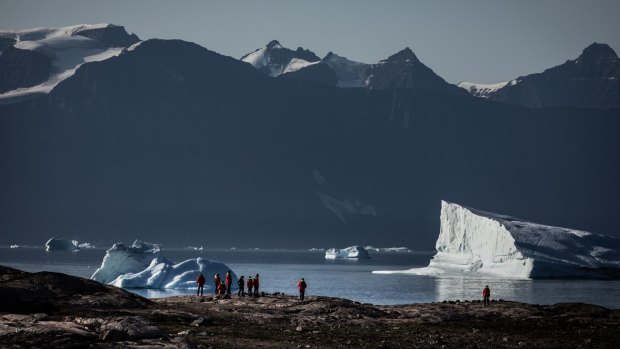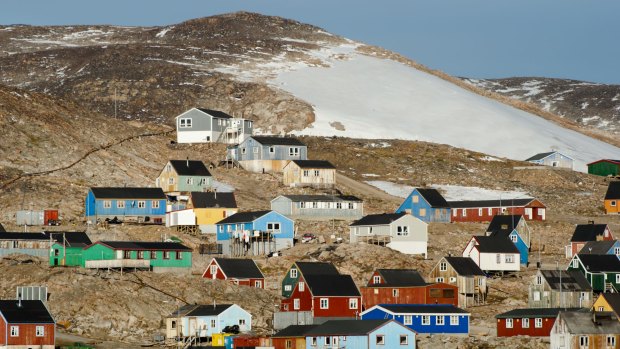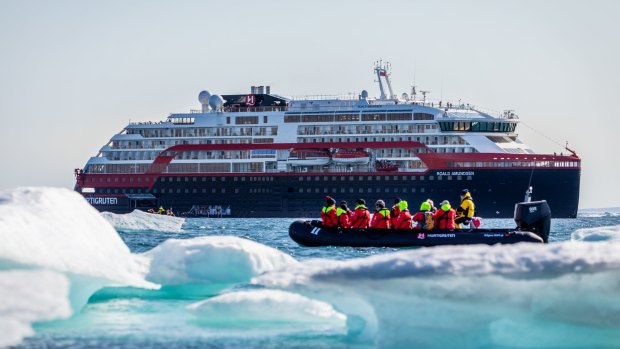This was published 1 year ago
Cruising to Ittoqqortoormiit, Greenland, and the world's least-visited national park
By Andrew Bain

Northeast Greenland National Park, the world's largest and least visited national park.Credit: Oscar Farrera
In the barren back blocks of Ittoqqortoormiit, beneath a cloudless sky, the town's public swimming pool is filled with children. It's midsummer and the scene might barely warrant a glance, except that this pool is more than 400 kilometres above the Arctic Circle and the temperature has just nudged five degrees. By local standards, it's the finest of summer days.
This small town now revelling in its cold blue summer is the most isolated settlement in Greenland, which by natural extension makes it one of the world's most isolated towns. That alone lends Ittoqqortoormiit an Arctic exoticism, but this town of about 450 people at the mouth of the world's largest fjord is also on the fringe of an even greater geographic claim.
Almost immediately to its north is the southern border of Northeast Greenland National Park, the world's largest and least visited national park.

Ittoqqortoormiit Village.Credit: iStock
If it were a country, this 972,000 square kilometre park would be the 30th-largest nation on Earth, bigger than Tanzania, Venezuela and Turkey, and before I arrive aboard Hurtigruten's Roald Amundsen expedition ship, only about 4000 people are thought to have visited it.
"More people have climbed Everest than have been in this national park," crew members assert as we cruise across the Greenland Sea towards the park's fjord-torn coast.
We come ashore at Myggbukta, the site of the first wireless radio station connecting Greenland to Europe in 1922, and where Norwegian trappers once raised their national flag in 1931 in an attempt to claim the area for Norway.

Roald Amundsen passengers weave their way between icebergs.Credit: Oscar Farrera
On an expedition ship in the Arctic, landing are mini-expeditions, especially when a polar bear has been sighted just offshore a couple of hours before. Before passengers are allowed to step into the national park, an armada of gear is transferred ashore, with enough food and shelter to last for several days in event of emergency. Expedition crew scout the area for bears and then stand in a wide ring around the site, watching for bears and the unlikely prospect of a hurried evacuation back to the ship.
Finally, we come ashore in Zodiacs, stepping where so few have ever stepped. Hardy wildflowers peep through the barren earth, and there's a tangle of cages outside the old tar paper covered radio station where wintering trappers once tried to raise Arctic foxes, only for the cages to be destroyed by the harsh Arctic conditions.
We climb to a low hill behind the beautifully preserved station, looking out over a place that's all kinds of surreal. It's an Alpine landscape at sea level, a frigid outback with icebergs and a High Country-like hut. Musk oxen graze the scant grasses a few hundred metres from the station, and the world seems trapped inside a band of sea ice.
It's through this great wall of ice that we weave for the next 24 hours, with the Roald Amundsen charting a slow and complex course towards the alphabet soup of Ittoqqortoormiit, one of only two towns on Greenland's east coast. It's situated on the end of a peninsula that was originally intended to be a part of the national park, but the township succeeded in having it excised to maintain the area as hunting grounds.
Ittoqqortoormiit's setting is both spectacular and spectacularly barren, with its homes huddled across a rock shelf beneath waves of low, lifeless mountains. From afar, it looks almost like confetti on a rocky path, but up close the red, blue, mustard and green homes appear like one side of a Rubik's cube.
The town's sole supermarket is restocked just four times a year, and the dazzling green artificial turf of its soccer pitch feels almost like an oasis in this rock desert.
Hunting remains vital to Ittoqqortoormiit's survival, with musk oxen, seals, walruses, narwhals, belugas and even polar bears still hunted. This day, two polar bear skins are hanging to dry outside homes. It's a confronting sight given the plight of the polar bear population, with its habitat diminishing in a warming climate, but it's part of Ittoqqortoormiit's quota of 35 bear kills a year, a figure deemed sustainable.
As I wander Ittoqqortoormiit's dirt streets, I meet local resident Ruth Aaqqii, who sits at the roadside spinning musk oxen wool. She tells me she came to the town for a single winter in 2006, and somehow never left.
"This sun and the blue days are very normal here for summer," she says. "In winter, there are quite a few days where you can't leave the house. Sometimes the school is closed and the store is closed because it's too dangerous to go outside. I cannot see the next house and you can get lost inside the village."
There are other days - regular days - where town life is disrupted by polar bears.
"On Tuesday we saw three bears here - a mother with two cubs - and they actually walked right up to a house with people inside, but the people shouted and made noises and scared them off," Ruth says.
As well as its proximity to Northeast Greenland National Park, Ittoqqortoormiit has another bold geographic boast. It sits on the shores of the world's largest fjord, Scoresby Sund, which cuts a wound more than 300 kilometres in length into the side of Greenland as it reaches north into the national park.
Leaving Ittoqqortoormiit, we sail into the fjord, where we'll spend a couple of days. Though the sea ice doesn't intrude into Scoresby Sund by the middle of summer, its waters are covered in icebergs from the multitude of glaciers lining its southern shores. There are icebergs that tower over the ship, which itself is 37 metres high, and likely reach to the ocean floor 300 metres below. It's like sailing through a ruined city carved from ice.
Scoresby Sund is a fjord that forks time and again into a series of smaller ones. Past an archipelago known as the 'iceberg graveyard', we leave the main fjord and sail into Ofjord, digging ourselves deeper into the icy land mass of Greenland.
The Greenlandic name for Ofjord - Ikaasakajik - translates as "the bad sound" in reference to the katabatic winds that typically scour it, but today it's as still as stone. This tucked-away fiord is our last stop in Greenland, but it's far and away the most spectacular - a chaotic and fantastic landscape of ice-scratched cliffs and motorway-wide glaciers.
It's like looking at New Zealand's fjords lined with Patagonia's peaks. Glaciers slalom down from the fragile, melting icecap that covers 80 per cent of the island, and mountains rise into sharp horns of rock, with cliffs so textured they look like fossilised wood.
The whole scene has the appearance of a grand mountain range compressed to less than 2000 metres in height. These mountains night not be Everests, but fewer people have seen them.
Andrew Bain travelled courtesy of Hurtigruten and Inspiring Vacations.
September is Cruise Month for the Cruise Lines International Association, marking the return to cruising in Australia, New Zealand and around the world. See cruising.org.au
TRIP NOTES
MORE
FLY
Finnair flies daily from Sydney and Melbourne to Oslo, connecting through Helsinki and either Hong Kong, Singapore or Tokyo. Norwegian Air Shuttle flies from Oslo to Longyearbyen, where this cruise begins. See finnair.com norwegian.com
CRUISE
Hurtigruten offers a range of Greenland and Arctic cruises, including the 13-day Greenland - the Ultimate Fjord and National Park Expedition. Inspiring Vacations books Hurtigruten cruise packages that include all airfares, accommodation and transfers. See hurtigruten.com.au inspiringvacations.com
FIVE LITTLE VISITED NATIONAL PARKS
GATES OF THE ARCTIC (ALASKA)
Grizzly bears, wolves, caribou migrations, no roads and less than 10,000 people a year in the US's least-visited national park.
SAVAGE RIVER (AUSTRALIA)
The most anonymous of Tasmania's 19 national parks has no road entry, no facilities and no real hope of being found by visitors, despite being less than 50 kilometres from Burnie.
DURMITOR (MONTENEGRO)
Shun the Montenegrin coast and seek out this mountainous treasure, cut by the Tara River Canyon, claimed to be the second-longest canyon in the world (behind the Grand Canyon).
LIUWA PLAINS (ZAMBIA
While the crowds gather around Africa's largest wildebeest migration in the Serengeti, sneak away to the second-largest migration at this park near the Angolan border.
MANU NATIONAL PARK (PERU)
Covering rainforest through to alpine grasslands, Peru's oldest national park stakes a bold claim as having the planet's greatest wildlife biodiversity.
Sign up for the Traveller Deals newsletter
Get exclusive travel deals delivered straight to your inbox. Sign up now.